Most smartphones are tilt-sensitive, but what device makes this possible? Additionally, how does it (and the sensors associated with it) work?
Also, since the working of these sensors seem, almost certainly, based on the presence of an external gravitational field (for instance, the earth's), this begs the second question: Do smartphones retain their tilt-sensitivity under zero-gravity (hypothetical) conditions?
(Recently played an aircraft simulator game on my phone...the fact that the plane responded so well to tilting took me aback; hence the urge to ask this question)
Extras:
I put some thought into this myself, so I'll be putting that up here too. For all intents and purposes, my question ended after the second paragraph, but what I've added after this might help tailor an answer that fits my current understanding of physics.
I'm currently in high-school, and if I recall correctly, there are six degrees of freedom for a particle in a 3D Cartesian system. From my experience with the aircraft simulator app, smartphones seem to detect motion in only three degrees of freedom: pitch, roll and yaw
Speaking of tilt-sensitive sensors: The way I assume these sensors/transducers work, is by detecting the minute changes in gravitational potential energy (which may manifest itself as small-scale motion of some tiny components of the sensor) that is associated with the phone's change in spatial orientation.
The way I see it, such a sensor would require moving parts, and cannot simply be another chip on a circuit board.
Under these circumstances, if I were tasked with building a tilt-sensitive device that perceives minute changes in gravitational potential energy, I would probably require at least 3 pairs of sensors (a pair in each of the three coordinate axes). Also, seeing how very sensitive my smartphone appears to be to tilting, I'd have to build a ridiculously large device, with each sensor in a pair placed several meters apart to achieve tilt-sensitivity comparable to that of my phone.
However, smartphones have dimensions smaller than that of a typical sandwich, so having "sensors in a pair placed several meters apart", apart from being impractical, is clearly not the case.
^ I went ranting about this, so that you can get a feel of my genuine perplexity in the sub-question that follows:
How come these sensors are so sensitive, despite their small size?




